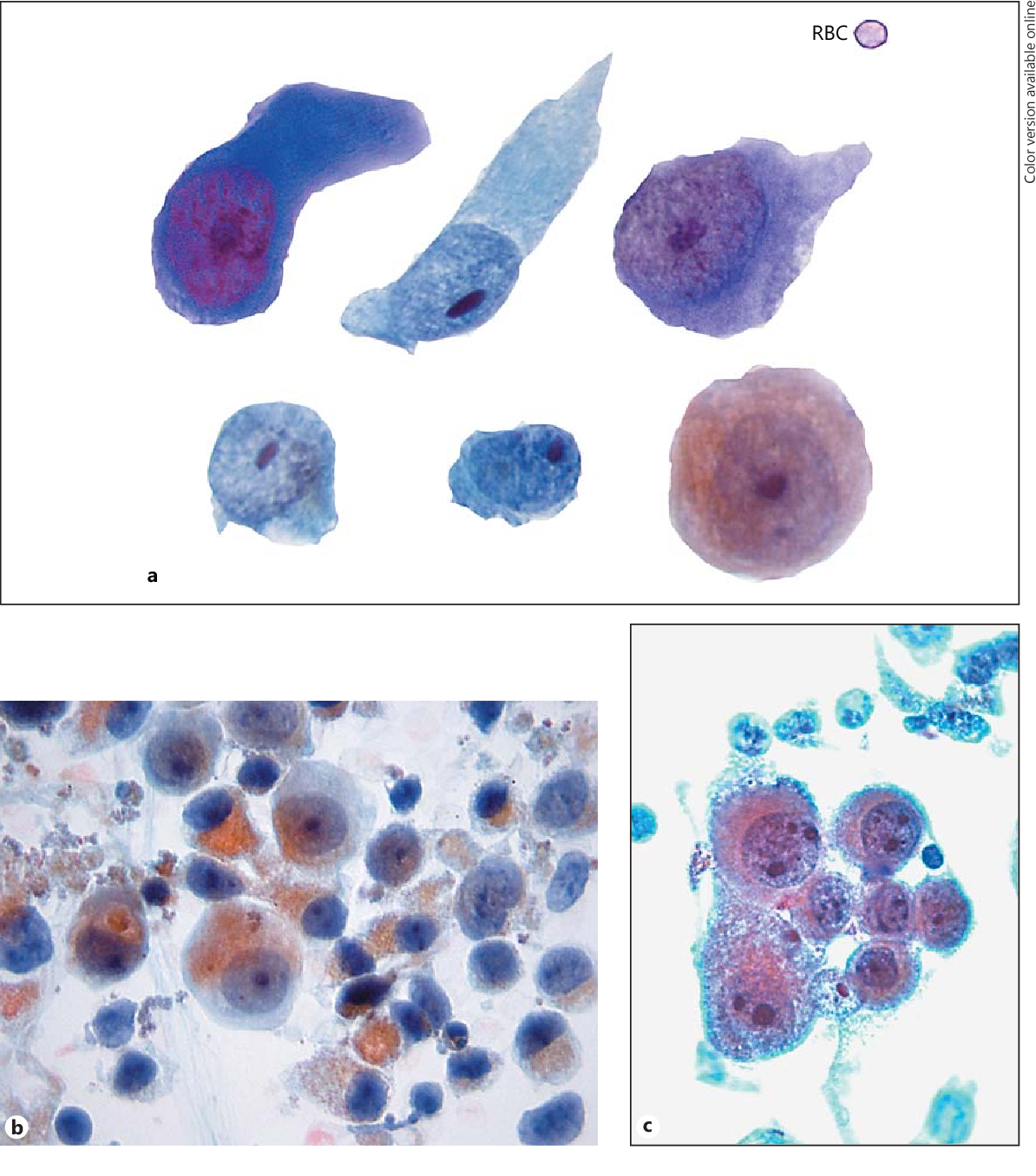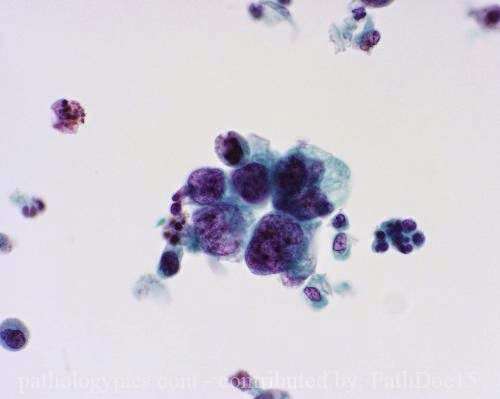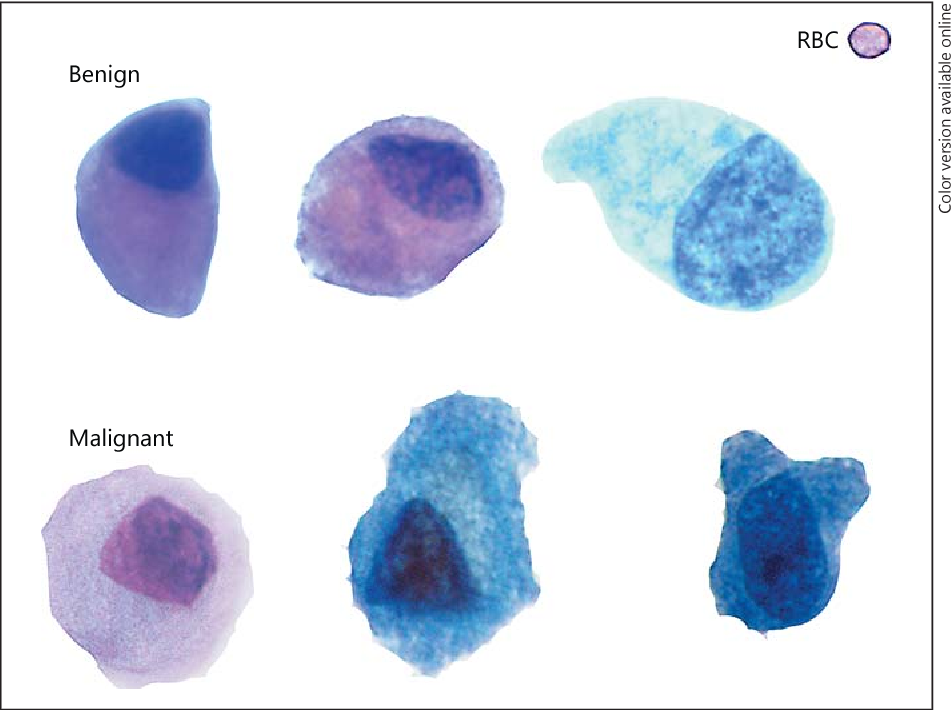Other Malignancies: Primary Metastatic And Miscellaneous Lesions
Primary malignancies of the urinary bladder, other than of urothelial origin, are rare and typically represent fewer than 5% of bladder tumors. They include squamous cell carcinoma, adenocarcinoma, and small-cell carcinoma. Their cytologic features are the same as those in other parts of the body.
Secondary malignancies in the bladder occur in fewer than 10% of bladder tumors. Most of these are direct invasion from prostate, cervix, uterus, or gastrointestinal tract. The most common distant metastases are malignant melanoma, and carcinomas of stomach, breast, kidney, and lung. Figure 7 is an example of adenocarcinoma of the prostate involving the urinary bladder.
Fig. 7
Prostatic adenocarcinoma involving urinary bladder . This urine specimen demonstrated mostly clusters of cells with high N/C ratio and prominent nucleoli. Although HGUC can show clustering and prominent nucleoli, these features are more commonly observed in adenocarcinomas, especially of prostatic origin. This patient did have a history of prostatic adenocarcinoma, Gleason score 4 + 4 = 8, and the cell block sections showed PSA-positive tumor cells.
Tests That Might Be Used To Look For Bladder Cancer
Tests for bladder cancer look for different substances and/or cancer cells in the urine.
Urinalysis: One way to test for bladder cancer is to check for blood in the urine . This can be done during a urinalysis, which is a simple test to check for blood and other substances in a sample of urine. This test is sometimes done as part of a general health check-up.
Blood in the urine is usually caused by benign problems, like infections, but it also can be the first sign of bladder cancer. Large amounts of blood in urine can be seen if the urine turns pink or red, but a urinalysis can find even small amounts.
Urinalysis can help find some bladder cancers early, but it has not been shown to be useful as a routine screening test.
Urine cytology: In this test, a microscope is used to look for cancer cells in urine. Urine cytology does find some cancers, but it’s not reliable enough to make a good screening test.
Urine tests for tumor markers: Newer tests look for certain substances in urine that might be a sign of bladder cancer. These include:
Screening For Bladder Cancer
Screening is the use of tests or exams to look for a disease in people who have no symptoms. At this time, no major professional organizations recommend routine screening of the general public for bladder cancer. This is because no screening test has been shown to lower the risk of dying from bladder cancer in people who are at average risk.
Some providers may recommend bladder cancer tests for people at very high risk, such as:
- People who hadbladder cancer before
- People who had certain birth defectsof the bladder
- People exposed to certain chemicals at work
Read Also: What Side Of The Body Is Your Bladder On
Urine Cytology And Urinary Biomarkers In The Diagnostic Evaluation Of Hematuria
Urine cytologic examination is highly sensitive and specific for the detection of high-grade urothelial carcinoma, but sensitivity decreases significantly for low-grade urothelial carcinoma, resulting in an overall sensitivity of 15.8% to 54.5%, and specificity of 95.0% to 100% for bladder cancer detection . Indeed, in a large study of patients with hematuria, the sensitivity and specificity of positive/suspicious/atypical cytology were 45.4% and 89.5%, respectively .
Meanwhile, although several urine biomarkers have been approved or cleared by the FDA for detection and surveillance of bladder cancer, few studies have been conducted to evaluate these markers in patients with MH who do not have a history of bladder cancer. Available assays include nuclear matrix protein-22 , bladder tumor antigen, fluorescence in situ hybridization for abnormalities of chromosomes 3, 7, 17, and 9p21 and immunocytology for carcinoembryonic antigen and mucin glycoproteins .
David G. Bostwick, in, 2020
When Would A Urine Cytology Test Be Needed

Your healthcare provider may want to do a urine cytology test if youre experiencing signs or symptoms of a urinary system cancer, including:
- Having blood in your pee .
- Experiencing frequent pain when you pee.
- Experiencing a burning sensation when you pee.
Urine cytology tests can help find some types of cancers, however, there are limitations. Just because a urine cytology test doesnt find cancer cells, it doesnt necessarily mean that the person is cancer-free. Because of this, healthcare providers often have the person have other tests alongside urine cytology tests and may repeat urine cytology at a later date.
Other reasons your healthcare provider might have you give a urine sample for a urine cytology test include:
- To check for cancer recurrence if youve had bladder cancer and have been treated for it.
- To monitor bacteria in your pee if you have frequent urinary tract infections .
- To test for certain viral diseases.
Recommended Reading: Bladder Frequent Urination At Night
What Should I Expect After A Urine Cytology Test
It may take a while to get your test results. Since there are limitations to urine analysis tests, your healthcare provider will likely ask you to have other tests or procedures to look for urinary system cancer. Because of this, your provider may want to get the results of all the tests before they share the results with you. Your provider will let you know their process for how theyll determine and share the results.
A Review On The Accuracy Of Bladder Cancer Detection Methods
Chao-Zhe Zhu1, Hua-Nong Ting1
1. Department of Biomedical Engineering, Faculty of Engineering, University of Malaya, Kuala Lumpur, Malaysia2. Department of Biomedical Imaging, Faculty of Medicine, University of Malaya, Kuala Lumpur, Malaysia3. Department of Surgery, Faculty of Medicine, University of Malaya, Kuala Lumpur, Malaysia
Corresponding author: Assoc. Prof. Dr. Hua-Nong TING, Department of Biomedical Engineering, Faculty of Engineering, University of Malaya, 50603 Kuala Lumpur, Malaysia. Tel: +603-7967 6882 Fax: +603-79561378 Email: tinghnedu.my.
Citation:J Cancer
Recommended Reading: Bladder Control Medication For Men
Watching For Possible Symptoms Of Bladder Cancer
No screening tests are recommended for people at average risk, but bladder cancer can be found early because it causes blood in the urine or other urinary symptoms. Many of these symptoms often have less serious causes, but its important to have them checked right away so the cause can be found and treated, if needed. If the symptoms are from bladder cancer, finding it early offers the best chance for successful treatment.
Cxbladder Is A Genomic Urine Test For Bladder Cancer That Improves Overall Detection Accuracy
Cxbladder is a non-invasive and easy-to-use genomic urine test that quickly and accurately detects or rules out bladder cancer. The test combines clinical risk factor markers with genetic information, measuring five biomarker genes to detect the presence or absence of bladder cancer.
When should you use Cxbladder?
- When you’ve seen blood in your urine
- If tests reveal you have blood in your urine
- When you have had bladder cancer and are being monitored for recurrence
Cxbladder provides greater certainty, resolving diagnostic ambiguity and improving overall detection accuracy. The use of Cxbladder can also reduce the need for further invasive procedures and testing.
Bladder cancer has a high risk of recurrence so patients who have been treated have unique monitoring needs to protect against the threat of the disease returning. Besides monitoring for signs and symptoms of bladder cancer, a cystoscopy to examine the inside of the bladder and urethra is recommended every 312 months for several years after completing bladder cancer treatment, depending on the risk of recurrence. For many patients, the frequency of cystoscopy required can be reduced with the use of Cxbladder, a non-invasive surveillance alternative.
Cxbladders proven accuracy makes it a reliable choice. With performance proven in over 10 peer-reviewed studies, Cxbladder is trusted by over 1,800 urologists in over 40,000 patients. The test is covered by Medicare and comes with the option of in-home sampling.
Also Check: Does Red Wine Irritate The Bladder
What Other Tests Might Be Needed
Your doctor will tell you exactly what the results of your test mean, however, a urine cytology test by itself can’t diagnose any disease. Your doctor will probably ask for more tests if your results are not normal.
You may need other tests to help diagnose problems with your urinary tract. Some common ones include:
Imaging studies. Your doctor may want to see a picture of your urinary tract. This can be done with X-rays or computed tomography scans. An X-ray can help find problems in the kidneys, ureter, or bladder. A CT scan uses X-rays and computer technology to create 3-D pictures of your urinary tract.
Cystoscopy. This is a procedure that lets your doctor look at the lining of your bladder and urethra. It’s done with a small tube called a cystoscope. The cystoscope has a small camera attached to it. The cystoscope is inserted into your urethra and moved up into your bladder. You may also have a ureteroscopy at the same time you have a cystoscopy. This procedure is done in a similar way. It uses an even smaller type of scope to look at the tubes that carry urine from your kidneys to your bladder. These tubes are called your ureters.
If you are experiencing any unusual symptoms like those mentioned above, you may want to talk to your doctor about a urine cytology test.
Show Sources
Tests For Bladder Cancer
Bladder cancer is often found because of signs or symptoms a person is having. Or it might be found because of lab tests a person gets for another reason. If bladder cancer is suspected, exams and tests will be needed to confirm the diagnosis. If cancer is found, more tests will be done to help find out the extent of the cancer.
Recommended Reading: Neoadjuvant Chemotherapy In Bladder Cancer
Why The Test Is Performed
The test is done to detect cancer of the urinary tract. It is often done when blood is seen in the urine.
It is also useful for monitoring people who have a history of urinary tract cancer. The test may sometimes be ordered for people who are at high risk for bladder cancer.
This test can also detect cytomegalovirus and other viral diseases.
How Is A Urine Cytology Test Done

These tests are done with a urine sample. The urine sample can’t be from the first time you urinate in the morning. The cells from your first-morning urine have been in your bladder overnight and might be too degraded to analyze. There are two ways a urine sample can be collected for a urine cytology test.
Clean catch. This is a way to collect a urine sample that will keep it from being contaminated by germs that you normally have on the skin around your urinary area. Your health care provider will give you a kit to collect your urine. To get a clean-catch sample, take the following steps:
Catheter. In some situations, a urine sample may be taken with a small tube called a catheter. A catheter is inserted into your urethra and moved up into your bladder. This method of collecting a sample poses a risk of urinary tract infection.
Recommended Reading: Who To See For Bladder Problems
How Accurate Is Cystoscopy In Bladder Cancer
Although cystoscopy is the gold standard for the detection of bladder cancer, the false negative results associated with cystoscopy can range from 10 to 40%.
Can bladder cancer be missed on cystoscopy?
Although cystoscopy remains a fundamental investigative tool in the detection and surveillance of bladder cancer, small papillary tumors or carcinoma in situ can be easily missed by standard white-light cystoscopy , which may account for early recurrence.
What is normal cystoscopy?
Cystoscopy is a surgical procedure. This is done to see the inside of the bladder and urethra using a thin, lighted tube. Cystoscopy is a procedure that uses a flexible fiber optic scope inserted through the urethra into the urinary bladder.
Can cancer be detected in urine?
Urinalysis can help find some bladder cancers early, but it has not been shown to be useful as a routine screening test. Urine cytology: In this test, a microscope is used to look for cancer cells in urine. Urine cytology does find some cancers, but its not reliable enough to make a good screening test.
Urine Cytology Tests To Detect Cancer Cells
In a urine cytology test, a sample of the patients urine is analyzed under a microscope.1,2 This test can reveal the presence of cancer cells or cells that are pre-cancerous, meaning that they are more likely to become cancer cells later. However, this test is not enough to provide a definite diagnosis on its ownit is possible for cancer cells to be present in the bladder even if no cancer cells are detected in the urine sample.
You May Like: Recall On Mesh Bladder Slings
When Will I Know The Results Of My Urine Cytology Test
The time it takes to get the results of your urine cytology test depends on certain factors, including:
- If the pathologist needs to look at more samples.
- If the test requires special stains or procedures.
- If your healthcare provider or the pathologist needs a second opinion.
- If you had other tests done.
- Processing time.
Every situation is unique, so your healthcare provider will give you a better idea of when to expect your results.
Urine Culture Testing To Check For Utis
Urine culture testing can be used to check for urinary tract infections.1 The symptoms of bladder cancers and urinary tract infections can be quite similar, so it is important for healthcare providers check for both infection and cancer if either could be the cause. To carry out this test, the urine sample is left in a dish in the laboratory for several days, which allows any bacteria that may be contained in the urine to grow.
Also Check: Why Do I Get Bladder Infections So Easily
Benefits Of Urine Testing
Urine testing has several advantages, including:
- Typically non-invasive and painless
- Ease of sampling, coupled with being quick and convenient compared with other tests and procedures
- Results can be obtained quickly
- Costs are often lower than those associated with other types of diagnostic tests and procedures
- Provides relevant, reliable information regarding patient health status
Urinalysis Testing For Blood In Urine
Urinalysis can be used to test a patients urine sample for the presence of blood in the urine.1-3 The medical term for the symptom of blood in the urine is hematuria. Many patients diagnosed with bladder cancer have the symptom of blood in the urine that is easily visible, but in some patients the amount of blood is so small that it is not visible to the naked eye. Urinalysis can detect very small amounts of blood in the urine, which can sometimes help to diagnose bladder cancer at an earlier stage, if bladder cancer is present. Urinalysis can also be used to check the levels of other substances, such as sugar, protein, and white blood cells, in a patients urine.
Recommended Reading: Immediate Relief For Bladder Infection
How Are Samples Collected
Requirements for urine sampling vary depending on the test/s being performed. Often the timing of collection is random, as dictated by the logistics of a doctor consult or access to a laboratory service. However, depending on the purpose of the test, certain urine voids of the day may be preferred. Collection of urine from all voids over a defined time period or sample collection at specific times after eating may also be necessary.
Urine samples are usually obtained by spontaneous voiding, using the clean-catch, midstream urine collection method. This involves voiding the first portion of urine into the toilet, collecting the midstream portion into a clean container, then voiding the remaining portion into the toilet. This method greatly reduces the risk of contaminants entering the sample. Less commonly, an invasive method of urine collection, such as placement of a urinary catheter, may be required.
Learn about Cxbladder’s easy-to-use in-home sampling system
Standardization Of The Reporting System

Anatomic pathologists serve as consultants to their clinical colleagues and patients, and pathology reports officially document this communication. To help clinicians choose the optimal management options for the patient, reports must accurately and clearly communicate the cytopathologic findings and outcome probability.
Pathologists actively use the terms suspicious’, indeterminate’, or atypical’ – all too often with resultant failure to provide a clear diagnostic and therapeutic path for clinicians. A survey of pathologists and clinicians performed by Redman et al. documented the need for a more standardized terminology for reporting cytopathology results and for the education of clinicians on that terminology. Although pathologists have paid attention to all elements of the pathology report , they have not focused on the issue of report comprehension. In a study looking at surgical pathology reports, surgeons misunderstood pathologists’ reports 30% of the time . One of the issues shared by patients and their advocates on Web sites dedicated to cancer advocacy is that different pathologists and/or different institutions use different highly technical terms to describe the same entities, predictably confusing to both patients and their clinicians.
Also Check: What Is The Best Medication For Bladder Infection
Preoperative Evaluation Of Urine Cytology
According to the judgment of the physician, urine samples for cytological examination were collected one to three times. The specimens with preoperative positive urine cytology could be detected by the following findings: 1) malignancy voided urine cells, 2) suspicious voided urine cells, and 3) both . Other cases were all deemed negative samples. Positive cytology indicated malignancy, while negative cytology indicated benign or normal tissue . The final judgment was confirmed by two pathologists who were blinded to the clinical outcomes.